Mother of the Church and Mary in Christian Art Nichols Books Summary
A contempo academic theory dates the oldest image to the 2nd century.
As summarized in a recent article , the Old and New Testament provide many descriptions of the words and actions of Jesus but none about his looks. That'southward why painters and icon-makers relied more often than not on creative canon, rather than realism, when they had to portray the Messiah in icons or frescoes. The same principle goes for Mary, as the scriptures exercise not provide many details well-nigh her appearance either.
Only by looking at the primeval depictions of the Blessed Female parent, nosotros can infer a lot virtually the main character traits that artists wanted to stress —from nurturing and motherly dear to obedience to God—and almost the different artistic styles adult past Christian communities during the first nine centuries of Christianity.
Take a look at these nine early images of Our Lady:
one. Dura-Europos Church building, Syria, 2nd century
Discovered in the 1920s by a team of archaeologists from Yale, the Dura-Europos Church in modern day-Syria is considered to be the primeval Christian church we currently know of. The team was able to recover its ancient artworks, dating dorsum to the 2d and 3rd centuries, including the delineation of a woman leaning over a well, which for a long time was considered to be a representation of the Samaritan adult female who speaks with Jesus abreast Jacob's well as recounted past John (4:ane-42) . Simply a recent theory proposed by Michael Peppard , an Associate Professor of Theology at Fordham University, has rejected this interpretation, arguing that the painting is actually a depiction of the Annunciation, when affections Gabriel announced to Mary that she would excogitate and give nascency to Jesus. Peppard points out that in written descriptions of the Annunciation found in second-century biographies of Mary, Gabriel reaches her as she is drawing h2o with a pitcher, much as the Dura-Europos prototype shows and in line with Byzantine-era images of the scene. Further study of the image also revealed details that are invisible to the naked center, such as 2 lines reaching the woman'south body, that propose the depiction of an incarnation. Based on such evidence, the Dura-Europos painting can be considered the outset ever portrait of the Holy Female parent.
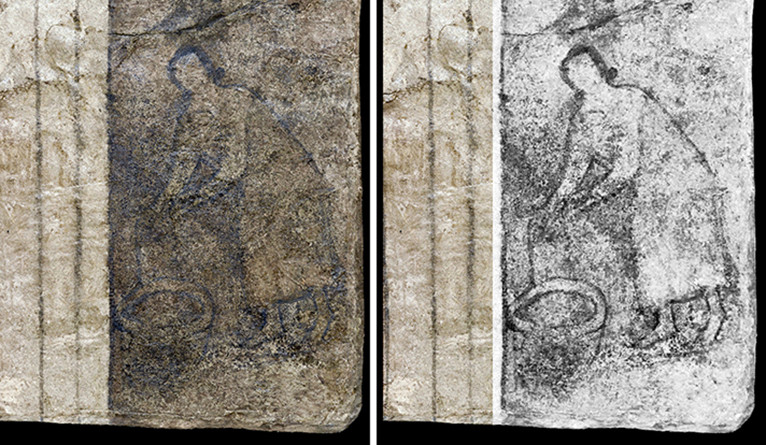
two. Madonna of the Catacombs, Rome, 3rd century
This paradigm painted on the walls of the Catacombs of Priscilla, located underneath Rome'southward Via Salaria in what used to be a quarry, show Mary as she is nursing a babe Jesus sitting on her lap and looking at the viewer. The artwork dates to the 3rd century, back when Christianity was even so an illegal do in Imperial Rome. Early Christians would meet in the catacombs to bury their dead and pray at the tombs of the martyrs, which is why artwork from this age tin tell u.s.a. a lot about the ideals and values of the very commencement Christian communities. In this fresco, Mary is depicted as she attends to the Christ Child, a symbol of her nurturing nature.
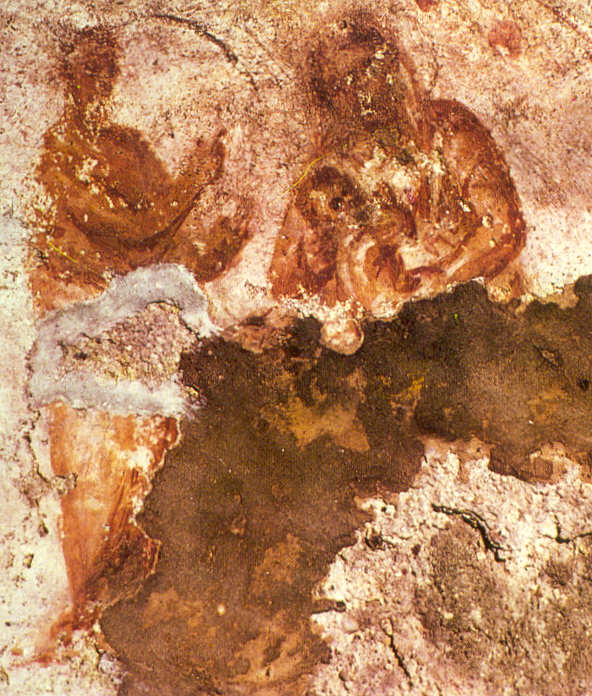
- Madonna with the Magi, Rome, third century
The Gospels lack descriptions of the appearance of Jesus and Mary just grow in descriptions of the deportment of the mother-and-son duo. One of the most popular actions to be depicted during the early days of Christianity was the arrival of the Magi after Jesus' birth. This image, dating to the tertiary century, depicts the Magi adoring the Christ Child, who is held by his female parent Mary. It was used to decorate a sarcophagus at present held at the Vatican Museums in Rome.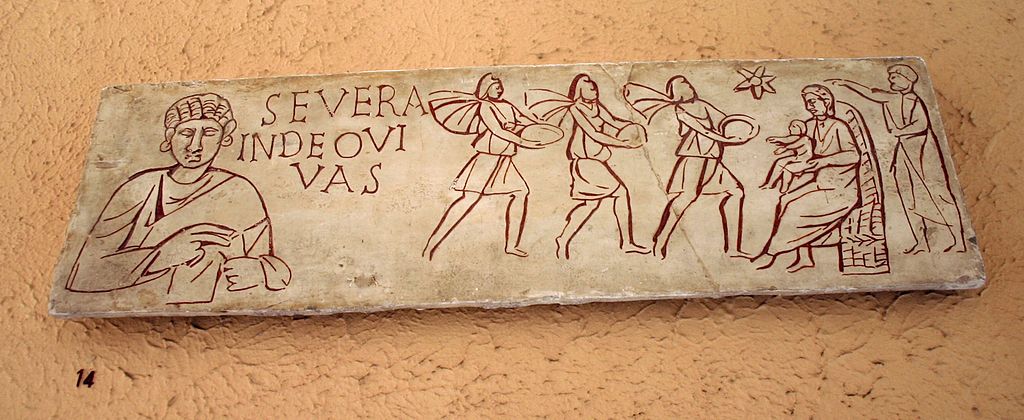
- Protectress of the Roman People, Rome, 5th century
One of the traditional Byzantine icons to emerge during the 5th century, when Christianity had become the official religion of the Roman Empire, depicts the Blest Mother as Salus Populi Romani , Latin for "health of the Roman People." This icon, painted on a cedar panel, depicts Mary with a dark blue pall trimmed with gilded over a imperial tunic, the typical dress of figures of power in 5th-century Rome. She is property the Christ Child, who is shown with a book in his left hand, presumably the Gospel. Unlike the 3rd-century representations of similar scenes, we come across Mary, rather than Jesus, looking directly at the viewer. Art historians accept long argued virtually a precise dating of this icon, and the consensus has it every bit a Tardily Antiquarian icon created in the 5th century that was over-painted during the 13th century. It is currently kept in the Pauline Chapel of the Basilica of Saint Mary Major in Rome.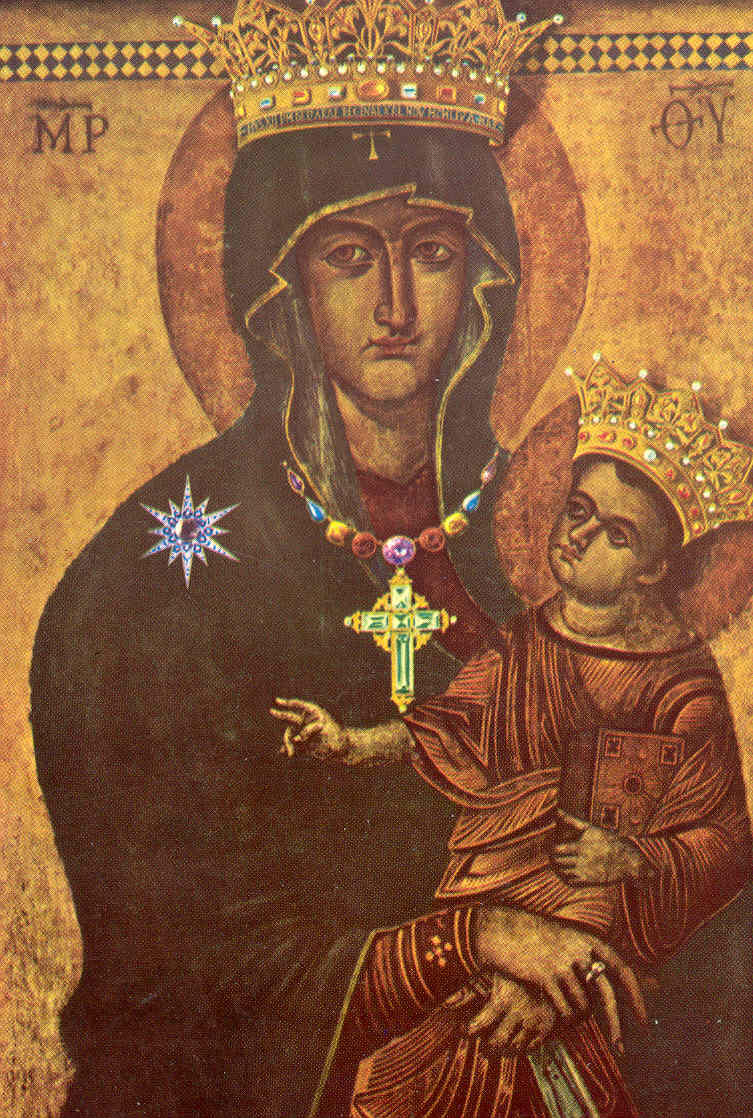
- Madonna and Kid enthroned amongst the angels and saints, Mountain Sinai, 6th century
Saint Catherine'southward Monastery was constructed in the second one-half of the sixth century about Mount Sinai, and currently stands as the oldest continuously inhabited monastery in the world. Among its impressive collection of ancient manuscripts and artworks lies an image of Mary and the Christ Child surrounded by St. Theodore of Amasea, St. George, and two angels. In this depiction, Mary is sitting on a throne, a symbol of power, and the two angels look at a divine head that seem to attain out from the heavens right on top of her head. The icon was created through the encaustic technique — using vegetable pigments that get burned with hot wax and spread on wooden surfaces — typical of 6th-century icon-making.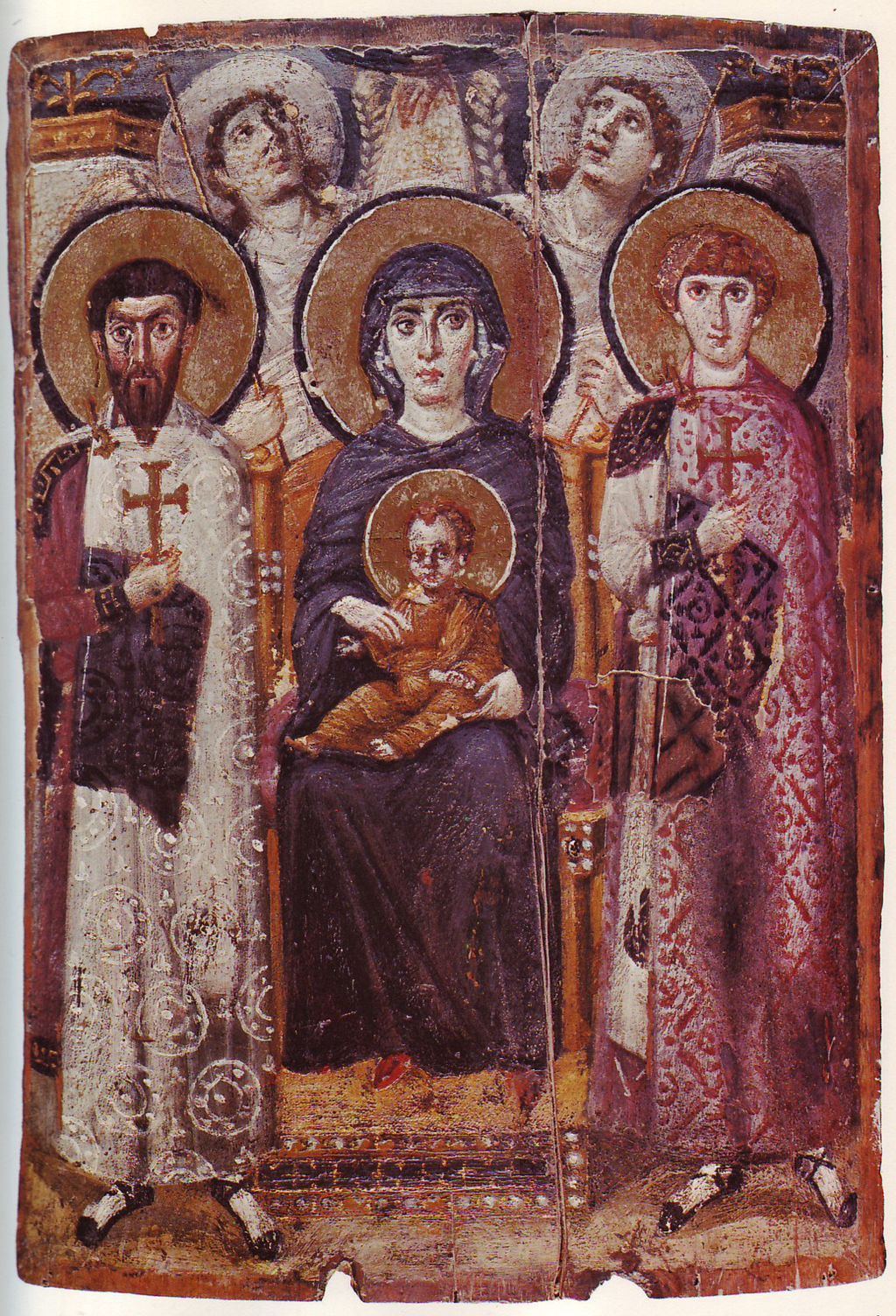
- Nativity, St. Catherine Monastery, Mountain Sinai, sixth century
Also constitute in St. Catherine's monastery, this encaustic Nativity icon depicts Mary attending to the Christ Child, who lies at the center of the limerick attended by the the ox and the ass. The Magi arrive from the right, while angels and the star hover above. Below the primal scene are vignettes depicting the celestial warning to Joseph (left) and nascency attendants bathing the Christ Kid.
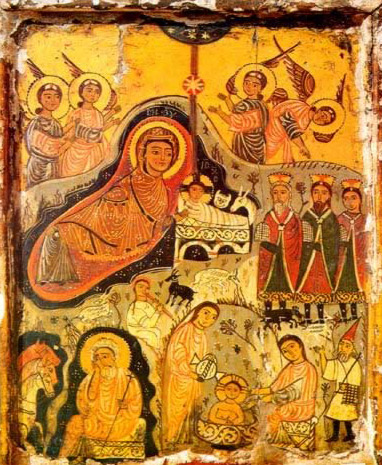
Nascence, St. Catherine Monastery, Mount Sinai, 6th century - Agiosoritissa (Female parent of God), Constantinople, 7th century
The icon of "Panaghia Agiosoritissa," also known as "Madonna the Advocate," is ane of the few icons that does not present Mary as mother. Here, the Virgin Female parent is presented as an "intermediary" between humans and God, capable of praying for intercession. This icon, currently preserved in the Church building of Santa Maria del Rosario, Monte Mario, Rome, was created in Constantinople during the seventh century.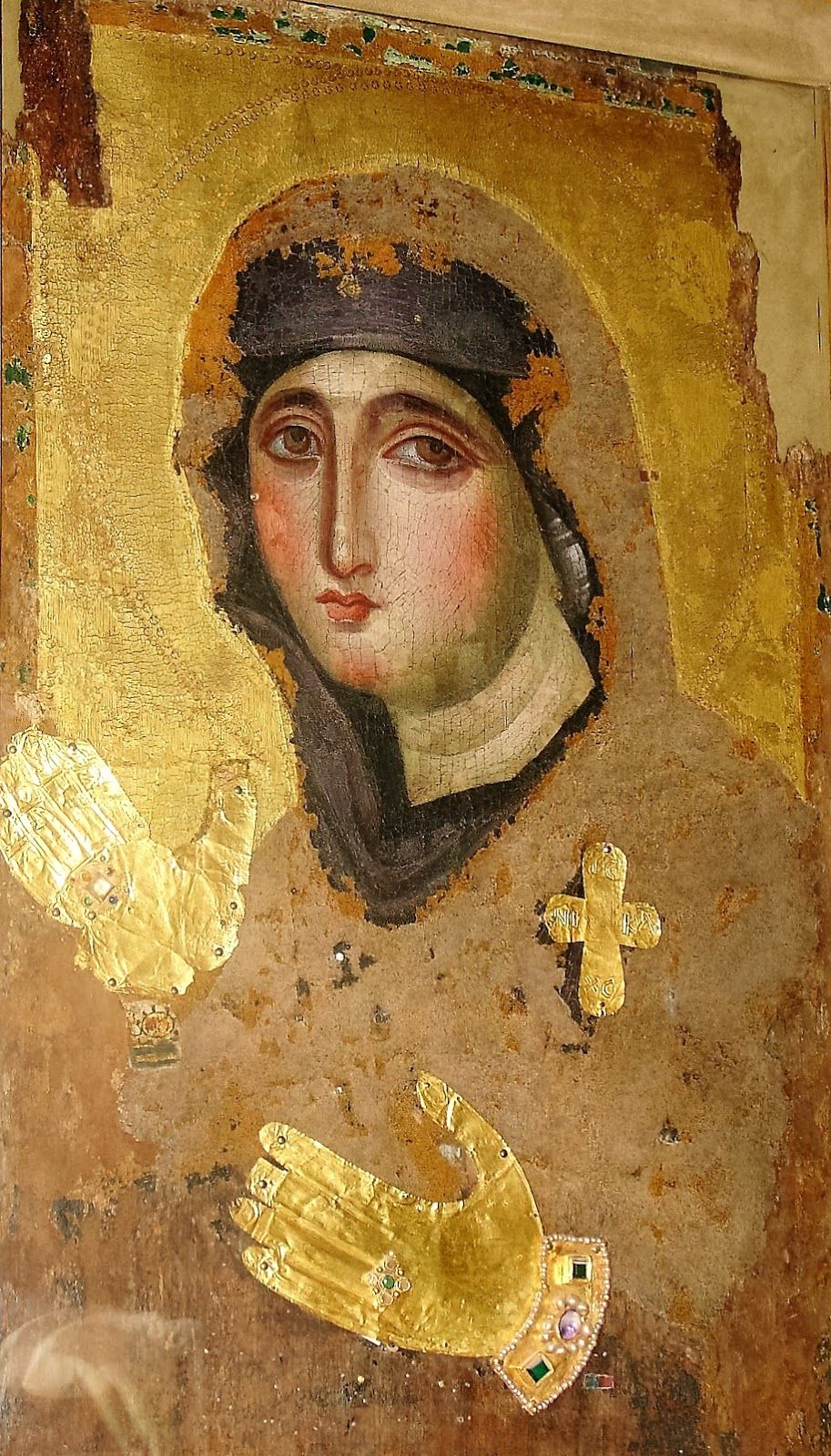
- Cover of copy of the Gospels, Frg, 8th/9th centuries
Before the invention of the press press (1439), the holy scriptures were reproduced by hand using papyrus, wax, and parchment and covered with wooden or metal covers. This ivory cover of a copy of the Codex Aureus of Lorsch , an illuminated Gospel Book created in Lorsch Abbey, Federal republic of germany, between 778 and 820, shows an enthroned Virgin Mary looking direct at the viewer as she holds the Christ Child on her lap. It is currently preserved at the Vatican Library in Rome.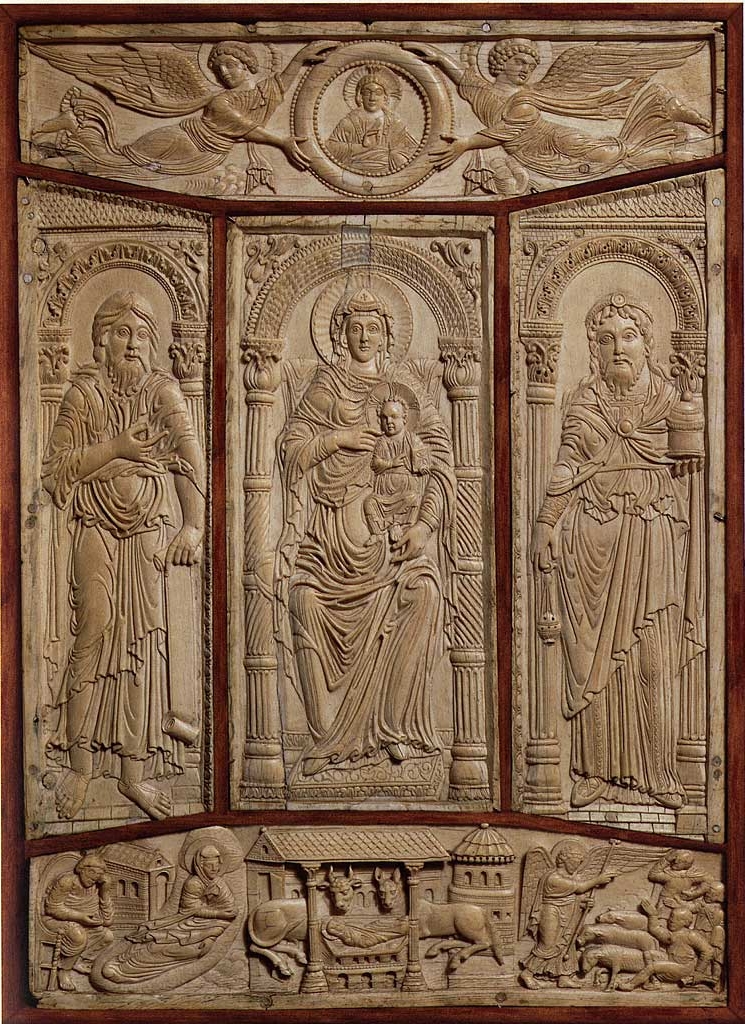
- Madonna and Child icon, 9th century
This icon, depicting Mary and the Child as they both look at the viewer, was created during the 9th century in Tsilkani, Georgia. For centuries information technology has been a revered image for believers in the Eastward European country, attracting many pilgrims to its original location. Today information technology is office of the permanent drove of the Art Museum of Georgia in the capital, Tbilisi.
- Protectress of the Roman People, Rome, 5th century
Enjoying your time on Aleteia?
Articles like these are sponsored complimentary for every Cosmic through the back up of generous readers but like you.
Thanks to their partnership in our mission, nosotros reach more than 20 million unique users per month!
Help united states of america keep to bring the Gospel to people everywhere through uplifting and transformative Cosmic news, stories, spirituality, and more than.
Support Aleteia with a gift today!

Source: https://aleteia.org/2018/10/19/the-9-oldest-images-of-mary/
0 Response to "Mother of the Church and Mary in Christian Art Nichols Books Summary"
Postar um comentário